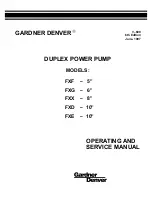
Operation
2-2
b.
Turn on the cooling water supply to the pump body and check that adequate flow is provided
by examining the amount of water discharged at the visual drain points.
c.
Switch on the power to the diffusion pump heater.
d.
Check inlet and forepressure performance by means of the system instrumentation.
e.
During operation, the gas load at the inlet of the diffusion pump should not exceed the
maximum throughput capability of the pump. This means that the pressure at the inlet flange
should not (except in transient conditions) exceed approximately 1 x 10
-3
(.133 Pa) Torr.
During operation, the discharge or fore pressure must be below the specified tolerable
forepressure.
2-2
SHUTDOWN PROCEDURE
a.
Switch off the power to the diffusion pump heaters.
b.
Admit cooling water to the quick-cool coil if necessary and continue to circulate it until the
pump body just above the boiler heat shield can be touched (approximately 130°F or 54°C).
In valved systems which have tight inlet and foreline connections, it is possible to close valves
to isolate the diffusion pump at inlet and discharge, to air-release the remainder of the
system, shut off the heat to the diffusion pump, and stop the mechanical pump. With this
method, the quick-cool coil does not have to be used. However, the water flow through the
pump must be maintained until the boiler cools down below approximately 300°F (150°C).
CAUTION
Do not operate the quick-cool coil when the pump is cold or out of ser-
vice to prevent harmful collection of condensation on the boiler plate,
heater, and heater terminals.
WARNING
Boiler temperatures reach 530°F (275°C) which can cause serious
burns when touched. Always ensure surfaces have cooled near room
temperature before touching them.
Air release or admitting air to a pump with a hot boiler, especially when
it is under vacuum, permits a strong oxidizer to contact the hot pump oil
and thereby increases the risk of an explosion.





































